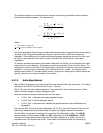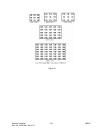
Where:
F
= The Top Hat Factor (area under the curve)
6.20 Effective Area and Effective Diameter
All of the pixels that are above the clip level are included in the Effective Area and Diameter results.
If an aperture is present then the analysis is confined to just the pixels inside the aperture. The sum of
the areas of all the pixels above the clip level is the Effective Area. The Effective Diameter is the
diameter of a circle that will just contain the Effective Area as shown below:
ed
ea
=×2
π
Where:
ed
= Effective diameter
ea
= Effective area
6.21 Far-Field Divergence Angle computations
The LBA-PC can calculate Far Field Full-Angle beam divergence in two orthogonal axes. Two methods
are provided, the Focal Length and the Far-Field. The Focal Length method requires the use of a
focusing optic, while the Far-Field method requires that all measurements be performed in the far-field
of your laser beam. Each method is discussed below. In each discussion you can assume results are
duplicated for each axis.
6.21.1 The Focal Length Method
This method is based upon the beam width of a focused beam’s spot size and the focal length of the
focusing optic. Divergence results will be computed in the X and Y aligned axes of the beam if
Elliptical results are disabled, or for Major and Minor axes beam orientations if Elliptical results
are enabled.
The Focal Length divergence method provides a means for finding the far-field beam divergence at
any point in the beam propagation path. As shown below, the calculation performed by the LBA is
quite simple, however the optical setup must be done with great care. The user to suit his particular
application must provide the optic. The focusing optic must be large enough to accommodate the
input beam, without introducing diffraction effects. You can use either refracting or reflecting
focusing optics, but in either case, you must place your camera’s detector at the exact focal length of
the optical element. The Divergence result is based upon the focused spot size as described in the
equation below:
divergence
W
f
f
=
−
tan
1
Where:
W
= The width of the focused spot at distance
f
from the optic.
f
Operator’s Manual LBA-PC
Doc. No. 10654-001, Rev 4.10
141


















